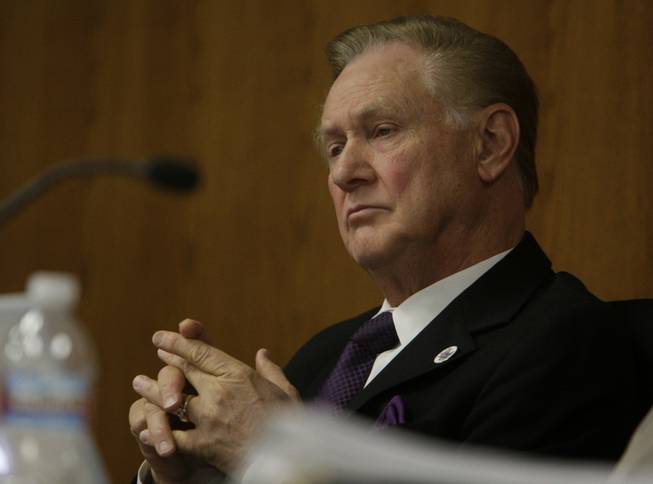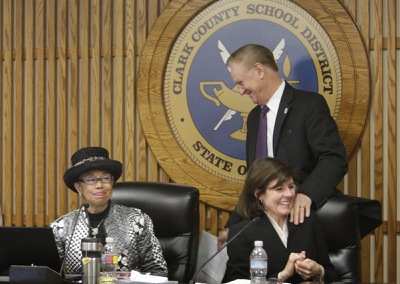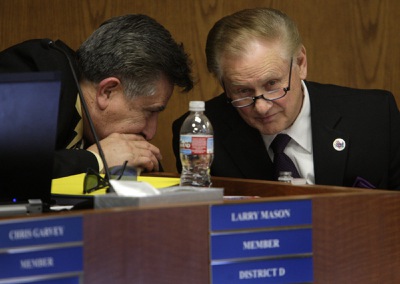
Clark County Schools Superintendent Walt Rulffes attends Thursday’s board meeting. He announced he will retire in August when his contract expires.
Friday, March 26, 2010 | 2:01 a.m.
Sun Archives
- Clark County schools superintendent announces retirement (3-25-2010)
- Superintendent Walt Rulffes gets national recognition for leading School District (1-12-2010)
- Superintendent Walt Rulffes: Schools need plan of action for success (12-27-2009)
- Rulffes has rough draft of fix for Prime Six (9-10-2009)
- Rulffes named Nevada superintendent of the year (6-30-2009)
- School District expects to save $1.1 million in reorganization (5-8-2009)
- New schools chief vows to improve grad rate (1-28-2006)
Walt Rulffes’ retirement as superintendent of the Clark County School District will throw the fate of several major initiatives into uncertainty, but he’ll leave a legacy of giving principals more power, students more choices and teachers a boost in teaching math.
His decision to step aside comes at a strained time for the School District — but when hasn’t it been?
Rulffes was promoted in 2005 to run the district — the nation’s fifth largest — at a time when unprecedented growth in Clark County was cresting and the district was as much about building schools as it was about building young minds.
And since then, with growth screeching to a halt and the recession starving the district of money, he’s been forced to prioritize programs and to try to do more with less.
It’s against that backdrop that Rulffes announced at Thursday’s School Board meeting that he will retire in August when his contract expires. He was chosen as superintendent in January 2006, after serving about six months as interim chief following the resignation of Carlos Garcia. Rulffes previously was the district’s chief financial officer.
For his various successes as boss of 38,500 employees, Rulffes had won national distinction. But he leaves with some goals not yet reached.
He had said he wanted the district to implement an open enrollment policy for the 2011-12 academic year, which would allow students to seek a seat at any campus with open seats, rather than having their school assignments determined by their addresses.
West Las Vegas is also waiting for word on the fate of the “Prime Six” schools, a holdover from an initiative implemented in the early 1990s as the district phased out its federally mandated busing program intended to promote diversity.
And after years of labor stability, the district is bracing for layoffs of administrators, teachers and support staff to help make up for a $123 million reduction in state funding. Rulffes is at odds with the administrators’ union, which is furious with him for attempting to reduce the district’s contribution to members’ retirement benefits. A mediator sided with the union, the district appealed and the matter is headed to court.
To be sure, his successor will forge his or her own path. But what’s clear is that some of Rulffes’ initiatives have taken root, and are likely to shape the district’s landscape for some years to come.
Empowerment
In 2006, the selection of a superintendent came down to two finalists — Rulffes, considered more a savvy money man than academic innovator, and Eric Nadelstern, a veteran New York City Public Schools administrator and reform advocate. He wowed the Clark County School Board with his “autonomy zone” pilot program, which granted more authority to principals and teachers without interference by central administrators. (The program was so successful that it’s since been expanded throughout the nation’s largest school district.)
Nadelstern eventually withdrew his name from consideration, and Rulffes got the job. But the School Board was smitten with Nadelstern’s autonomy concept. Rulffes’ first major project as superintendent was to set up a pilot program using four elementary schools. It was called “empowerment.”
Although Nadelstern might have planted the seed, Rulffes cultivated the program and steered its expansion to 17 schools, with another 10 to join in August.
In 2007, lawmakers set aside $9 million for a statewide empowerment pilot program, but the money was eliminated the following winter. Rulffes found private corporate donors to pick up the slack.
And, along the way, he turned a former critic into a supporter — Maureen Peckman, executive director of the Council for a Better Nevada, a private group of business and industry leaders that had recruited and backed Nadelstern for superintendent. Peckman and the council helped land $13.5 million from the Lincy Foundation, which oversees billionaire Kirk Kerkorian’s philanthropic endeavors.
Because of the budget crisis, there’s no additional money for new empowerment campuses.
And as a result, Rulffes has made it easier for the program to continue, and even expand. There is hope that empowerment will come into a windfall: The U.S. Education Department is granting hundreds of millions of dollars to help turn around low-performing campuses using innovative models, as well as to districts that develop significant public-private partnerships. The empowerment program appears poised to qualify in both categories.
Career and technical education
Early on, Rulffes wanted to expand the district’s career and technical education program, calling it the best bet for reducing the dropout rate and improving the graduation rate. He persuaded the School Board to approve building five academies, an investment of hundreds of millions of dollars in what’s a relatively new formula for high school education.
In traditional vocational programs, students were split off from their college-bound peers. But nationally that model has largely given way to magnet programs in which academics and training in specific fields are given equal emphasis. Nevada — and particularly Clark County — has led the charge.
The earliest version is Southeast Career and Technical Academy, formerly Vo-Tech, where the dropout rate is 2 percent and the graduation rate is approaching 90 percent. The model has been successfully replicated at four academies built in the northwest, southwest, east and west valley. The fifth and final campus, Veterans Tribute Career and Technical Academy, opened in August.
To encourage students to consider academies beyond their neighborhood campuses, each school offers programs that can be found only at that site.
A recent congressional study found that such programs particularly benefit minority students and those from low-income and middle-income households. And results have been equally impressive for Clark County’s students.
In addition to the trades typically associated with vocational programs, such as welding and construction, the career and technical schools offer classes in such fields as health care, computer programming and travel and tourism.
The dropout rate has improved for two consecutive years and educators say some of the credit goes to the career and technical academies that better hold the interests of some students.
Raising the bar
Shortly after being named superintendent, Rulffes teamed up with Jim Rogers, then chancellor of the Nevada System of Higher Education, to tackle the problem of why so many district graduates were unprepared for college.
To that end, the district in 2007 added a fourth year of mathematics to its graduation requirement.
The School District is also working with higher ed officials to determine in which areas its graduates are most deficient, so it can provide remedial help to seniors before they graduate and get frustrated in college.
Rulffes established common semester math exams in 2008 to better measure instruction districtwide, and the first results were dismal. Teachers were then given better materials and support to prepare students.
As a result, the pass rate the next year for middle schoolers ranged from 51 percent in pre-algebra (up from 47 percent in 2008) to 73 percent in Algebra I (compared with 47 percent in the test’s first year). High schoolers also improved in algebra and geometry, with pass rates ranging from 21 percent to 43 percent (compared with 9 percent to 22 percent in 2008). But the overall failure rate remains unnervingly high.
After the release of the test results in January, Rulffes said the district would continue to use the services of its expert math committee, and that teachers would get increased professional support to help them review their instructional techniques and ensure students are prepared for the material.
The School Board will now have to decide what it wants in its next superintendent.




Join the Discussion:
Check this out for a full explanation of our conversion to the LiveFyre commenting system and instructions on how to sign up for an account.
Full comments policy